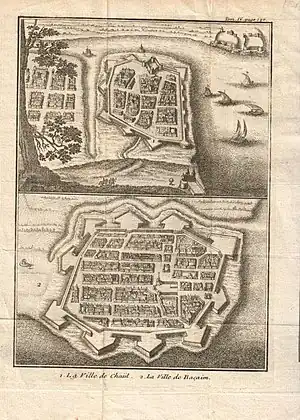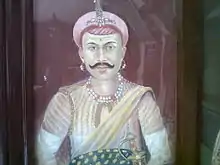Battle of Vasai
The Battle of Vasai or the Battle of Bassein was fought between the Marathas and the Portuguese rulers of Vasai (Portuguese, Baçaim; English, Bassein), a town near Mumbai (Bombay) in the Konkan region of the present-day state of Maharashtra, India. The Marathas were led by Chimaji Appa, a brother of Peshwa Baji Rao I. [2]
| Battle of Vasai (Bassein) | |||||||
|---|---|---|---|---|---|---|---|
 The Portuguese fortresses of Chaul (above) and Bassein (below) in an 18th century print | |||||||
| |||||||
| Belligerents | |||||||
|
| |||||||
| Commanders and leaders | |||||||
|
|
| ||||||
| Casualties and losses | |||||||
|
800 killed Unknown Wounded[1] | |||||||
Background
By 1736, the Portuguese had been at work for four years constructing the fortress of Thana, and aside from the long delays, the workers were unpaid and unfed.[3] The locals who were tired of the oppression, finally invited the Marathas to take possession of the island of Salsette, preferring their rule to the oppression of the Portuguese. These were some of the factors that weakened Baçaim and set the stage for Maratha attacks.
After the war of 1737- 39, Chimaji Appa and his Maratha soldiers took the church bells from Vasai as memorabilia and installed them in various Hindu temples of Maharashtra, some of the bells they installed in the Khandoba Temple of Jejuri & the Tulja Bhavani Temple of Osmanabad respectively. These church bells are still present in these temples.[4] The garrison of Baçaim, thanks to the reinforcements received from Goa, was of about 1,200 soldiers, among Portuguese and Indian auxiliaries.[5]
Siege of Baçaim
The siege of Baçaim began on 17 February 1739. All the Portuguese outposts around the major fort at Baçaim had been taken. Their supply routes from the north and south had been blocked, and with the English manning the seas, even that route was unreliable. Chimaji Appa arrived at Bhadrapur near Baçaim in February 1739. According to a Portuguese account, his forces numbered 40,000 infantry, 25,000 cavalry, and around 4,000 soldiers trained in laying mines. Furthermore, he had 5,000 camels and 50 elephants. More joined from Salsette in the following days, increasing the total Maratha troops amassed to take Baçaim to close to 100,000. The Portuguese, alarmed at this threat, decided to vacate Bandra, Versova and Dongri so as to better defend Baçaim. As per orders of the Portuguese Viceroy, the Count of Sandomil, only Baçaim, Damão, Diu and Karanja (Uran) were to be defended. These were duly fortified. In March 1739, Manaji Angre attacked Uran and captured it from the Portuguese. This was followed by easy Maratha victories at Bandra, Versova and Dharavi which the Portuguese garrison had vacated. Manaji Angre joined Chimaji Appa at Vasai after this. Thus by April 1739, the noose around Baçaim had further tightened.

The capture of Thana and Dharavi meant that even small boats could not reach Baçaim without being fired upon by Maratha cannons. Still, General Martinho De Silva decided to fight. Chimaji Appa now decided to bring down the fort itself.

Within the fort itself, the towers of São Sebastião and Nossa Senhora dos Remedios faced the Marathas at Bhadrapur. The barracks and everything else was inside, with the main gate facing the Vasai creek. Chimaji Appa began the siege on 1 May 1739 by laying 10 mines next to the walls near the tower of Remedios. Maratha soldiers charged into the breach caused by exploding four of them. Almost immediately, they came under fire from Portuguese guns and muskets. Chimaji Appa, Malhar Rao Holkar, Ranoji Shinde and Manaji Angre goaded their contingents to scale the walls throughout the day. Next day on 2 May, the tower of São Sebastião and Remedios were repeatedly attacked. More mines were set off during the day, causing large breaches in the walls, between the two towers. Around 4,000 Maratha soldiers tried to pour into the fort, but the Portuguese opposition was fierce. They also managed to defend the two towers by lighting firewood. On 3 May, the tower of São Sebastião was demolished by a Maratha mine. Maratha armies could now easily march into the fort, without the fear of being fired upon from the tower. The encirclement and defeat of the Portuguese was complete. Chimaji Appa decided to settle the war at this point by sending an envoy to the Portuguese. In his letter, he warned them that the entire garrison would be slaughtered and the fort levelled if the war continued. The Portuguese commander in charge of the fort duly surrendered on 16 May 1739. The Maratha general ordered that the rest of the garrison leaved Baçaim with unfurled colours, muskets at the shoulder and playing drums, and that they were transported by sea to Mumbai (Bombay).[6] On 23 May 1739, the saffron flag flew atop Baçaim.[7]
References
- "Chapter2 : Maratha-Portuguese". Archived from the original on 13 August 2021. Retrieved 11 November 2017.
The Portuguese losses amounted to eight hundred officers and men killed and unknown number wounded.
- Jaques, Tony (2017). Dictionary of Battles and Sieges: A–E. Greenwood Publishing Group. ISBN 9780313335372. Retrieved 12 November 2017 – via Google Books.
- Pritchett, Frances. "10chapter". Columbia.edu.
- "Why bells from Portuguese-era churches ring in temples across Maharashtra". Hindustan Times. 22 December 2018. Retrieved 13 January 2022.
- Saturnino Monteiro, Armando da Silva (1996). Batalhas e Combates da Marinha Portuguesa (PDF) (in Portuguese). Lisbon: Livraria Sá da Costa. p. 148.
- Saturnino Monteiro, Armando da Silva (1996). Batalhas e Combates da Marinha Portuguesa (PDF) (in Portuguese). Lisbon: Livraria Sá da Costa. p. 154.
- "Maharashtra State Gazetteers Greater Bombay District". 17 February 2009. Archived from the original on 17 February 2009.